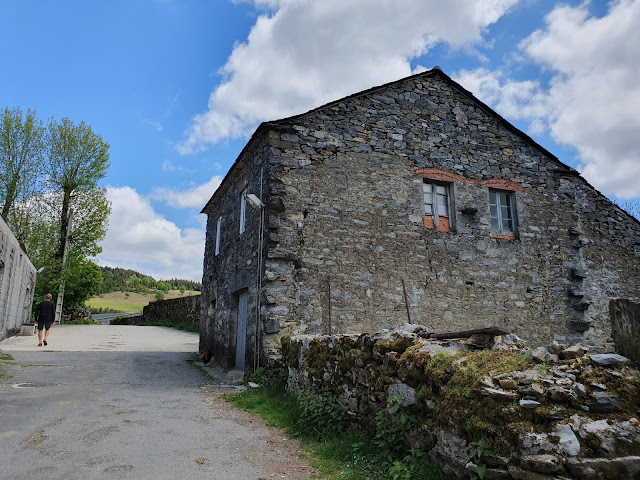Day 41
Las Herrerías to Liñares - 12 kms
21 May 2019
Today was short on kilometres but big in other ways. We went from 705 metres at Las Herrerías to 1380 metres a bit further on from O'Cebreiro. This was the third, and last, of the very high points on our Camino - the first was when we walked over the Pyrenees and the second was a few days ago when we went over Cruz de Ferro. Another reason why today was a big day was because we are now in Galicia, our final region, the region of Santiago de Compostela. The end of our Camino is getting closer. Our walk took us through La Faba and Laguna de Castilla on our way to O'Cebreiro - both very small farming settlements - then down to Liñares, another very small farming settlement where we're staying tonight.
Throughout our Camino we have been mindful of the thousands of pilgrims who have gone before us, especially when on hill tracks such as we had today - narrow, steep, rocky and, at times, muddy. What was it like for the pilgrims of old? The first recorded evidence of people making this pilgrimage is from the 10th century; by the 12th and 13th centuries as many as 250,000 pilgrims walked each year. St Frances of Assisi made a pilgrimage to Santiago in 1214. What conditions did they walk in? What clothes and shoes did they wear? What dangers did they face? Thank goodness there were men such as St Dominic of Calzada who in the 11th century spent his life building bridges and improving the route for pilgrims. These pilgrims of old would walk from their homes and then walk back - some present day pilgrims still walk from their homes wherever that may be - France, Germany, the Netherlands - but not many walk back although we have seen a few walking in the opposite direction. We really are walking in the footprints of history - also in the footprints of family and friends who have walked this Camino in the last few years.
 |
| Leaving Las Herrerías |
 |
| This is the real start of our walk for today - off up into the hills for 8.5 kms |
 |
| Pappy's house is a pilgrim shelter so it will be perfect for Pilgrim Pappy - it may be a bit draughty, especially on a cold night, but at least he'll have a roof over his head. |
 |
| In the village of La Faba |
 |
| The baptismal font |
 |
| Out of La Faba and we continue on our way up |
 |
| The village of Laguna de Castilla - the last village we walked through in the Castilla y León region. In this farm building the stock are kept in the ground floor and the family live above them. |
 |
| Breakfast time |
 |
| ...and we are still climbing |
 |
| So so beautiful |
 |
| The point where we entered Galicia. |
 |
| 160.948 kilometres to Santiago. We will have these way markers all the way to Santiago. |
 |
| At O'Cebreiro |
 |
| A Galician palloza in O'Cebreiro - a traditional house in north-west Spain. |
 |
| The Church of Santa Maria in O'Cebreiro - it dates from the 9th century. It is the oldest church directly associated with the Camino. |
 |
| St James |
 |
| An O'Cebreiro street |
 |
| Looking out from O'Cebreiro |
 |
| ...and on our way to Liñares: |
 |
| An unnamed village in the distance. |
 |
| Looking down on Liñares, our destination for the day. The air is cool and crisp as we are at 1230m. |
 |
| San Esteban Church in Liñares |
 |
| The alter in San Esteban Church |
 |
| All the stock are kept indoors in Liñares |












































History of that age is hard to grasp
ReplyDeleteYes it certainly is.
DeleteReally breathtaking sights. So interesting reading. What a big climb, a big achievement for all the pilgrims.
ReplyDeleteThe pilgrims of old must have been incredible people driven by their faith.
Yes, what did they wear on the hike through the mountains, they didn't have Kathmandu stores to help them out. St James would have had difficulty in his gowns. Lots of questions there.....
Not sure how I'd go with the cattle living below!!!! Buildings don't look sound or smell proof!!!!!
Thank you for sharing. xxx
Yes the pilgrims of old must have had very strong faith ...but not all. Sometimes men were told to walk the Camino for penance but made their servants walk it for them.
ReplyDeleteYes the living quarters of the cattle housed indoors are very malodorous 😳